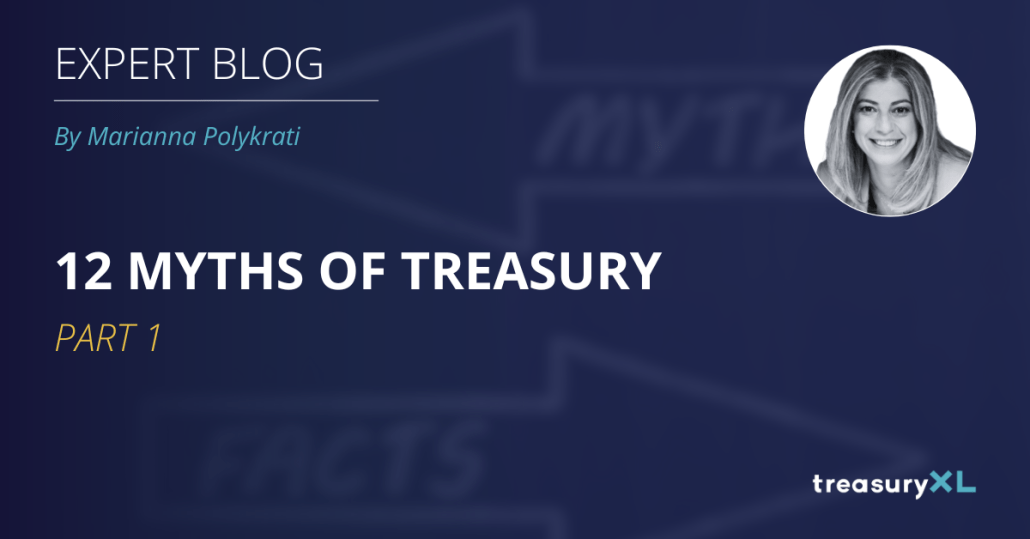Myth 1: “Treasury is just about Cash Management”
Treasurers are often seen as mere cash managers, limited to handling payments and ensuring liquidity. Some organizations treat treasurers as the “cashiers” of the company, while there are even CFOs reserving tasks like debt negotiations with banks – the perceived “glamorous” side of treasury – for themselves.
Treasury goes far beyond cash management. It’s a strategic function that safeguards financial stability, manages risk, and drives growth through proactive planning and collaboration. Treasurers are not just managing the present they’re shaping the future of the business.
Myth 2: “Treasurers don’t need to understand the Business“
Treasurers are often viewed as isolated from the broader business, focusing solely on numbers and financial transactions. Many believe that understanding the company’s operations, strategy, or market dynamics isn’t essential for their role.
Treasurers must deeply understand the business to manage liquidity, risks, and funding effectively. Their role requires a comprehensive view of the company’s operations and strategic goals to make informed decisions and align financial strategies with business needs.
From my own experience, I’ve seen how critical this understanding is. The more we understand the business and communicate within the organization with all the business units, the more we can add strategic depth to our role and provide solutions.
I recall a case where a CIO was exploring a Treasury Management Systems (TMS) without involving treasury in the process. The lack of collaboration could have led to a solution that didn’t meet the company’s actual needs, emphasizing the importance of treasury being part of key business decisions.
I’ve often collaborated internally with teams like procurement, logistics and HR. I remember instances when they brought issues to my office, and together, we worked on solutions that balanced financial strategy and operational needs. These moments underline the value of treasury’s deep involvement in the business.
On the other hand, knowing the business and being able to guide through site visit banks or external stakeholders, have made my feel great satisfaction whilst showcasing the operations firsthand. This helps them not only understand our business better but also strengthens our relationship and credibility.
Treasurers are not just “number people.” They are business partners who bring financial expertise into the operational, strategic, and external landscapes of a company.
Myth 3: “Treasury and Accounting are the same things“
Treasury and Accounting are often seen as interchangeable roles within finance. Treasurers are assumed to perform tasks like bank transactions and account reconciliations or interest accounting entries, leading to the belief that their work and responsibilities are identical to those of accountants. Some even argue that Treasury should report to Accounting or even that salaries should be equivalent, perpetuating the misunderstanding.
Treasurers are not Accountants. Their role requires a different skill set, a broader understanding of financial markets, and a strategic mindset. Recognizing this distinction is key to unlocking treasury’s full potential.
While Treasury and Accounting share common ground, they serve distinct purposes. Accounting is backward-looking, focused on recording and reporting historical financial information. Treasury, on the other hand, is forward-looking, focused on managing liquidity, mitigating risks, and aligning financial strategies with the company’s long-term goals.
Separating these two functions is essential for compliance and governance. For example, if Treasury manages payments and also reconciles bank accounts, there’s no independent oversight, increasing the risk of errors or fraud. By keeping these functions separate, companies create a system of checks and balances that enhances transparency and accountability.
Another reason for separation lies in the different areas of expertise. Treasury for instance focuses on forecasting and securing funding to maintain liquidity, while Accounting ensures accurate reporting and compliance with financial regulations. Each department’s specialization allows them to complement each other effectively without overlap. At the end, the true success lies in fostering strong collaboration between these departments to achieve aligned financial goals.
Catch the recording of Marianna and her fellow panelists discussing Generational Diversity in Treasury!
As generational diversity reshapes treasury teams, fresh perspectives meet time-tested strategies. But with it come challenges and opportunities in communication, expectations, and work styles. Marianna’s insights are not to be missed












